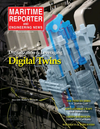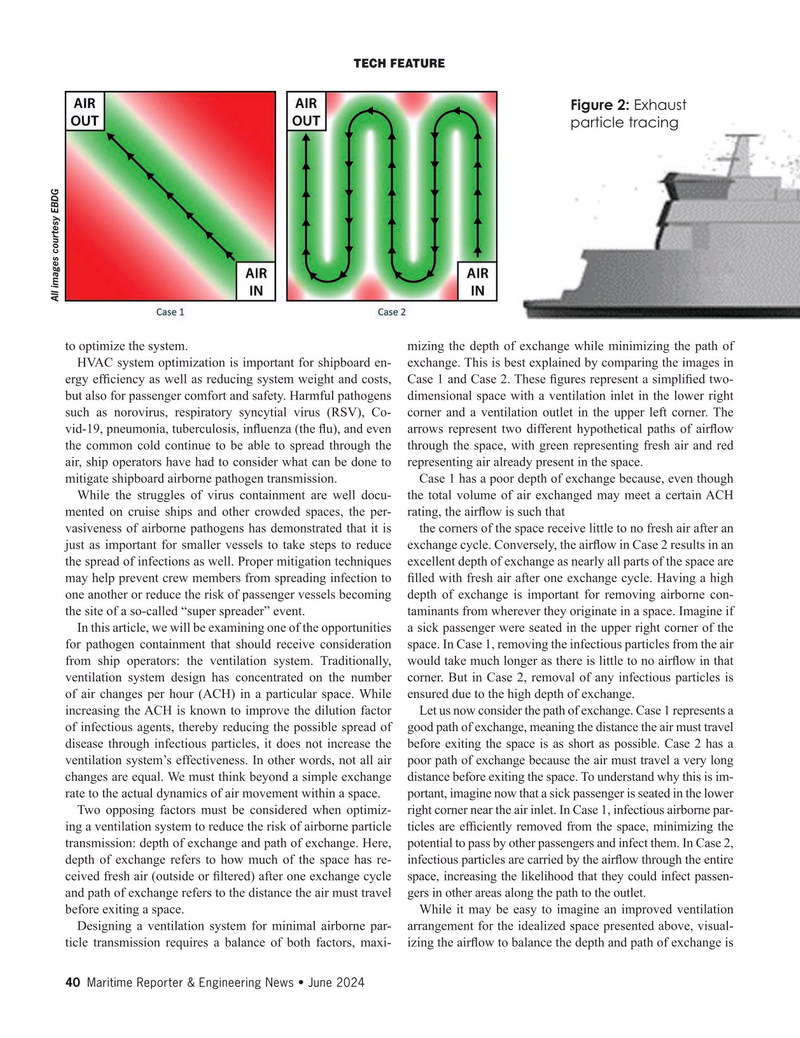
Page 40: of Maritime Reporter Magazine (June 2024)
Read this page in Pdf, Flash or Html5 edition of June 2024 Maritime Reporter Magazine
TECH FEATURE
Figure 2: Exhaust particle tracing
All images courtesy EBDG to optimize the system. mizing the depth of exchange while minimizing the path of
HVAC system optimization is important for shipboard en- exchange. This is best explained by comparing the images in ergy ef? ciency as well as reducing system weight and costs, Case 1 and Case 2. These ? gures represent a simpli? ed two- but also for passenger comfort and safety. Harmful pathogens dimensional space with a ventilation inlet in the lower right such as norovirus, respiratory syncytial virus (RSV), Co- corner and a ventilation outlet in the upper left corner. The vid-19, pneumonia, tuberculosis, in? uenza (the ? u), and even arrows represent two different hypothetical paths of air? ow the common cold continue to be able to spread through the through the space, with green representing fresh air and red air, ship operators have had to consider what can be done to representing air already present in the space.
mitigate shipboard airborne pathogen transmission. Case 1 has a poor depth of exchange because, even though
While the struggles of virus containment are well docu- the total volume of air exchanged may meet a certain ACH mented on cruise ships and other crowded spaces, the per- rating, the air? ow is such that vasiveness of airborne pathogens has demonstrated that it is the corners of the space receive little to no fresh air after an just as important for smaller vessels to take steps to reduce exchange cycle. Conversely, the air? ow in Case 2 results in an the spread of infections as well. Proper mitigation techniques excellent depth of exchange as nearly all parts of the space are may help prevent crew members from spreading infection to ? lled with fresh air after one exchange cycle. Having a high one another or reduce the risk of passenger vessels becoming depth of exchange is important for removing airborne con- the site of a so-called “super spreader” event. taminants from wherever they originate in a space. Imagine if
In this article, we will be examining one of the opportunities a sick passenger were seated in the upper right corner of the for pathogen containment that should receive consideration space. In Case 1, removing the infectious particles from the air from ship operators: the ventilation system. Traditionally, would take much longer as there is little to no air? ow in that ventilation system design has concentrated on the number corner. But in Case 2, removal of any infectious particles is of air changes per hour (ACH) in a particular space. While ensured due to the high depth of exchange.
increasing the ACH is known to improve the dilution factor Let us now consider the path of exchange. Case 1 represents a of infectious agents, thereby reducing the possible spread of good path of exchange, meaning the distance the air must travel disease through infectious particles, it does not increase the before exiting the space is as short as possible. Case 2 has a ventilation system’s effectiveness. In other words, not all air poor path of exchange because the air must travel a very long changes are equal. We must think beyond a simple exchange distance before exiting the space. To understand why this is im- rate to the actual dynamics of air movement within a space. portant, imagine now that a sick passenger is seated in the lower
Two opposing factors must be considered when optimiz- right corner near the air inlet. In Case 1, infectious airborne par- ing a ventilation system to reduce the risk of airborne particle ticles are ef? ciently removed from the space, minimizing the transmission: depth of exchange and path of exchange. Here, potential to pass by other passengers and infect them. In Case 2, depth of exchange refers to how much of the space has re- infectious particles are carried by the air? ow through the entire ceived fresh air (outside or ? ltered) after one exchange cycle space, increasing the likelihood that they could infect passen- and path of exchange refers to the distance the air must travel gers in other areas along the path to the outlet.
before exiting a space. While it may be easy to imagine an improved ventilation
Designing a ventilation system for minimal airborne par- arrangement for the idealized space presented above, visual- ticle transmission requires a balance of both factors, maxi- izing the air? ow to balance the depth and path of exchange is 40 Maritime Reporter & Engineering News • June 2024
MR #6 (34-44).indd 40 6/3/2024 11:56:26 AM

 39
39

 41
41
